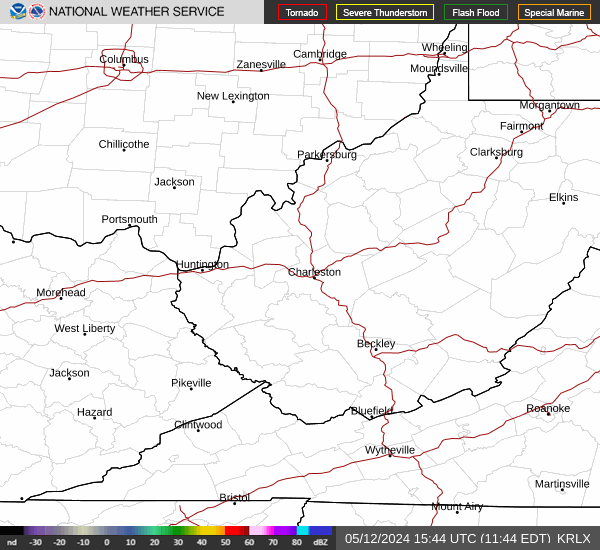Issued: 8pm on Sunday, April 27th 2025
Technical Forecast Discussion
Short-Term Forecast (Sunday 04/27/2025 through Tuesday 04/29/2025):
Currently, aloft, is experiencing an omega blocking pattern with an upper-level ridge providing northwesterly flow to the Ohio Valley with a cut-off low just off the East Coast near Maine. Another cut-off low is located in the Western United states just west of the Rocky Mountains, which will aid in support for the severe weather heading into the early work week. The upper-level ridging and strong high-pressure at the surface will aid in sunny and dry conditions due to surface divergence and upper-level convergence allowing for air sink at the surface and cause the surface pressure to increase. Therefore, this upper-level support in aid of a warm column of air in the atmosphere will promote a warming trend over the next couple of days. Temperatures today will reach near 70 degrees warming into the low-80s by Monday and Tuesday. Winds will remain relatively calm and switch to southwesterly once the upper-level ridge begins to move off to the east.
On Tuesday, high-pressure will begin to fill in as upper-level convergence weakens. The cut-off low over the western United States and Central Plains will become positively tilted aiding in a southwesterly flow regime. A very pronounced jet streak of upwards of 90 knots at the 500mb level will aid in a baroclinic environment over the Great Lakes Region as a shortwave trough forms. While there is a higher shear environment to the north and northeast near the Great Lakes, southeast Ohio will have an environment with weak shear as southeast Ohio is further from ample upper-level forcing. Bulk shear of around 30 knots is possible, which would aid in multicell clusters of storms and perhaps a weak discrete supercell or two if any storms formed ahead of the cold front.
At the 700mb level, in support of the shortwave trough, relative humidity is above 70% with strong vertical velocities indicating that parcels have reached saturation and Cumulonimbus Clouds or thunderstorm clouds are likely to form. This is in support of the surface midlatitude cyclone that is deepening as it moves northeast and warm air advection as the warm front lifts Tuesday morning. This will aid in an unstable airmass as moisture is advected northward with dewpoints in the mid-60s and lifted indices around -7, which indicates an unstable atmosphere. Convective Available Potential Energy or CAPE in the mixed layer is as upwards of 2000 J/kg. Therefore, southeast Ohio is indicative of a high instability and low shear environment in support of multicell clusters, which could merge into a squall line or line of storms once the cold front moves through the region Tuesday night into Wednesday morning.
Currently, the Storm Prediction Center (SPC) as southeast Ohio under a slight risk for severe weather (level 2 of 5) with the primary threats being damaging wind gusts and large hail. The tornado threat with this system is on the low-end as there is minimal low-level directional shear to aid in low-level rotation, but an isolated spin-up cannot be ruled out. Model guidance shows morning convection clearing out before reaching southeast Ohio, but is still uncertain at this time. If any morning convection were to occur, it would limit the daytime surface heating limiting the ability for the atmosphere to destabilize and the severe threat would be on the lower end. If there is ample daytime heating, then the severe threat is higher. Despite the uncertainty, an isolated shower or storm is possible late afternoon and into the evening. A line of storms is likely to develop with the greatest severe threat to occur between 8:00pm and 2:00am overnight Tuesday as the cold front moves through the region. Stay tuned for any updates at your local NWS office and here at The Scalia Laboratory for Atmospheric Analysis.
with the primary threats being damaging wind gusts and large hail. The tornado threat with this system is on the low-end as there is minimal low-level directional shear to aid in low-level rotation, but an isolated spin-up cannot be ruled out. Model guidance shows morning convection clearing out before reaching southeast Ohio, but is still uncertain at this time. If any morning convection were to occur, it would limit the daytime surface heating limiting the ability for the atmosphere to destabilize and the severe threat would be on the lower end. If there is ample daytime heating, then the severe threat is higher. Despite the uncertainty, an isolated shower or storm is possible late afternoon and into the evening. A line of storms is likely to develop with the greatest severe threat to occur between 8:00pm and 2:00am overnight Tuesday as the cold front moves through the region. Stay tuned for any updates at your local NWS office and here at The Scalia Laboratory for Atmospheric Analysis.
Long-Term Forecast (Wednesday 04/30/2025 through Saturday 05/03/2025)
Unfortunately, April is going to end relatively wet as this active weather pattern continues this week. Once the cold front moves through Wednesday morning, it will begin to stall once a secondary low-pressure system from the Central Plains will start to undergo its beginning stages in the midlatitude cyclone cycle as a stationary front forms and two areas of strong high-pressure remain north of the Great Lakes and off the east coast in the Atlantic Ocean. This is in conjunction with a consistent troughing pattern as the trough from the west begins to progress eastward into the region aiding in upper-level divergence and positive vorticity advection providing height falls and vertical motion in support of more showers and thunderstorms. Wednesday may see a break in the rain through the morning and afternoon before some chances of showers begin to move in the afternoon and overnight hours.
Showers and thunderstorms will begin to develop sometime in the afternoon on Thursday as another warm front lift over the region aiding in warm air advection and moisture advection with dewpoints again in the mid-60s and temperatures back in the low-80s after a brief cooldown in the mid-70s on Wednesday. However, storms this time around will not be severe. The cold front will move through Friday morning aiding in chances for rain through early Friday afternoon as cooler air settles in behind as northerly flow remains from the deep trough of cold air that will seep in some cold air advection behind the front. Finally, high-pressure will settle back in at the surface on Saturday with cooler than seasonal temperatures in the mid-60s and low overnight in the upper-30s to low-40s. A less active weather pattern is possible heading into the weekend as another omega blocking pattern forms and weather patterns remain stagnant heading into the second week of May.




